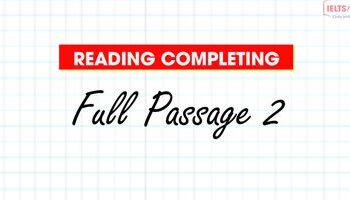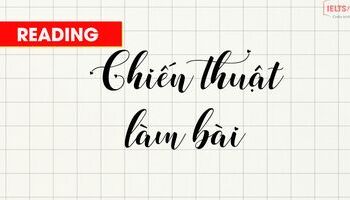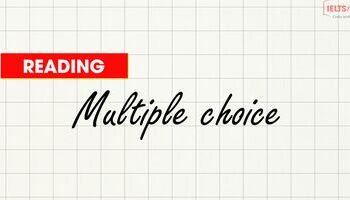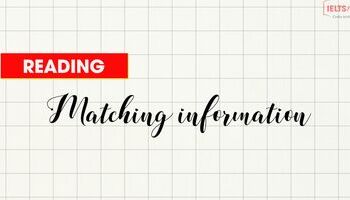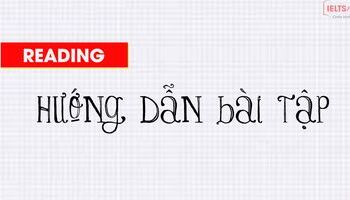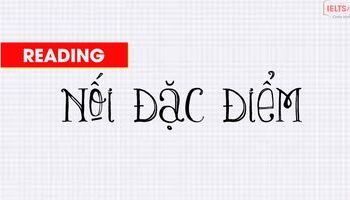I. REVIEW
Completing Notes/Summaries không phải là một dạng bài tập quá khó nếu có chiến thuật đúng đắn và luyện tập thường xuyên. Hôm nay hãy cùng IELTS-Fighter ôn lại chiến thuật làm bài cho dạng bài tập này và cùng thử sức với một Full Passage các bạn nhé.
Ở phần bài tập này, chúng ta có thể được cung cấp một danh sách hoặc phải tự tìm từ để điền vào các Notes/ Summaries. Chiến thuật làm bài phần này sẽ là:
- Lưu ý số lượng từ có thể điền vào một vị trí
- Cố gắng dự đoán đáp án
- Dự đoán loại từ cần điền (Noun/ Verb/ Adjective/ Adverb)
- Xác định xem đáp án sẽ đi chung với những từ khóa nào
- Tìm từ đồng nghĩa (synonyms) /paraphrases các từ khóa đấy
Bây giờ chúng ta cùng luyện tập bằng một đoạn văn ngắn nhé:
II. FULL PASSAGE
Visual Symbols and the Blind
Part 1
From a number of recent studies, it has become clear that blind people can appreciate the use of outlines and perspectives to describe the arrangement of objects and other surfaces in space. But pictures are more than literal representations. This fact was drawn to my attention dramatically when a blind woman in one of my investigations decided on her own initiative to draw a wheel as it was spinning. To show this motion, she traced a curve inside the circle (Fig. 1). I was taken aback, lines of motion, such as the one she used, are a very recent invention in the history of illustration. Indeed, as art scholar David Kunzle notes, Wilhelm Busch, a trend-setting nineteenth-century cartoonist, used virtually no motion lines in his popular figure until about 1877.
When I asked several other blind study subjects to draw a spinning wheel, one particularly clever rendition appeared repeatedly: several subjects showed the wheel's spokes as curves lines. When asked about these curves, they all described them as metaphorical ways of suggesting motion. Majority rule would argue that this device somehow indicated motion very well. But was it a better indicator than, say, broken or wavy lines-or any other kind of line, for that matter? The answer was not clear. So I decided to test whether various lines of motion were apt ways of showing movement or if they were merely idiosyncratic marks. Moreover, I wanted to discover whether there were differences in how the blind and the sighted interpreted lines of motion.
To search out these answers, I created raised-line drawings of five different wheels, depicting spokes with lines that curved, bent, waved, dashed and extended beyond the perimeters of the wheel. I then asked eighteen blind volunteers to feel the wheels and assign one of the following motions to each wheel: wobbling, spinning fast, spinning steadily, jerking or braking. My control group consisted of eighteen sighted undergraduates from the University of Toronto.
| Words associated Agreement among with circle/square subjects(%) SOFT-HARD 100 MOTHER-FATHER 94 HAPPY-SAD 94 GOOD-EVIL 89 LOVE-HATE 89 ALIVE-DEAD 87 BRIGHT-DARK 87 LIGHT-HEAVY 85 WARM-COLD 81 SUMMER-WINTER 81 WEAK-STRONG 79 FAST-SLOW 79 CAT-DOG 74 SPRING-FALL 74 QUIET-LOUD 62 WALKING-STANDING 62 ODD-EVEN 57 FAR-NEAR 53 PLANT-ANIMAL 53 DEEP-SHALLOW 51 |
All but one of the blind subjects assigned distinctive motions to each wheel. Most guessed that the curved spokes indicated that the wheel was spinning steadily; the wavy spokes, they thought; suggested that the wheel was wobbling; and the bent spokes were taken as a sign that the wheel was jerking. Subjects assumed that spokes extending beyond the wheel's perimeter signified that the wheel had its brakes on and that dashed spokes indicated the wheel was spinning quickly.
In addition, the favored description for the sighted was favored description for the blind in every instance. What is more, the consensus among the sighted was barely higher than that among the blind. Because motion devices are unfamiliar to the blind, the task I gave them involved some problem solving. Evidently, however, the blind not only figured out meaning for each of motion, but as a group they generally came up with the same meaning at least as frequently as did sighted subjects.
Part 2
We have found that the blind understand other kinds of visual metaphors as well. One blind woman drew a picture of a child inside a heart-choosing that symbol, she said, to show that love surrounded the child. With Chang Hong Liu, a doctoral student from china, I have begun exploring how well blind people understand the symbolism behind shapes such as hearts that do not directly represent their meaning.
We gave a list of twenty pairs of words to sighted subjects and asked them to pick from each pair the term that best related to a circle and the term that best related to assure. For example, we asked: what goes with soft? A circle or a square? Which shapes goes with hard?
All our subjects deemed the circle soft and the square hard. A full 94% ascribed happy to the circle, instead of sad. But other pairs revealed less agreement: 79% matched fast to slow and weak to strong, respectively. And only 51% linked deep to circle and shallow to square. (see Fig. 2) When we tested four totally blind volunteers using the same list, we found that their choices closely resembled those made by he sighted subjects. One man, who had been blind since birth, scored extremely well. He made only one match differing from the consensus, assigning 'far' to square and 'near' to circle. In fact, only a small majority of sighted subjects-53%- had paired far and near to the opposite partners. Thus we concluded that the blind interpret abstract shapes as sighted people do.
Complete the summary below using words from the box. Write your answers in boxes 33 –39 on your answer sheet. NB You may use any word more than once.
In the experiment described in Part 2, a set of word 1.......…… was used to investigate whether blind and sighted people perceived the symbolism in abstract 2.....…...… in the same way. Subjects were asked which word fitted best with a circle and which with a square. From the 3...…...… volunteers, everyone thought a circle fitted ‘soft ’while a square fitted ‘hard’. However, only 51%of the 4.......…… volunteers assigned a circle to 5.....…… .When the test was later repeated with 6...…...… volunteers, it was found that they made 7...…...… choices..
| associations blind deep hard hundred identical pairs shapes Sighted similar shallow soft words |
III. DISCUSSION
Các em đã tư duy như thế nào nhỉ? Chúng ta cùng check lại nhé:
(1) Tìm trong Part 2. Cần một danh từ ghép với từ “word” tạo thành một cụm danh từ. Danh từ này phải đi gần với các từ khóa như “A set”. Tuy nhiên, trong đoạn văn trên, rất có thể người viết không dùng từ “set” mà thay thế bằng từ khác hoặc một số cụ thể
-->> We gave a list of twenty pairs of words..
-->> Đáp án: Pairs
(2) Cần danh từ đi chung với từ “abstract” hoặc synonyms của từ này
-->> Thus we concluded that the blind interpret abstract shapes as sighted people do.
-->> Đáp án: Shapes
(3) Cần tính từ đi chung với danh từ “volunteers”, đứng gần các từ khóa như “everyone”, “soft”, “hard”. Tuy nhiên, từ “everyone” có thể được paraphrase thành từ nào đấy mang ý nghĩa tuyệt đối
-->> We gave a list of twenty pairs of words to sighted subjects
-->> All our subjects deemed the circle soft and the square hard
-->> Đáp án: Sighted
(4) Cần tính từ đi chung với danh từ “volunteers”, gắn với từ khóa “51%”
-->> Đoạn văn vẫn đang nói về Sighted
-->> Đáp án: Sighted
(5) Giải thích như trên
-->> Đáp án: Deep
(6) Cần một tính từ đứng trước danh từ “volunteers”, trái ngược với sighted
-->> Đáp án: Blind
(7) Cần tính từ đứng trước danh từ “choices”. Dựa vào đoạn thông tin có nhắc đến “blind volunteers/ subjects”
-->> Thus we concluded that the blind interpret abstract shapes as sighted people do.
-->> Đáp án: Similar
Completing notes/summaries không phải là một phần khó. Quan trọng nhất đối với dạng bài tập này là khả năng bắt keyword và tìm synonym/paraphrase keyword đó. Do đó khi học từ các bạn chú ý luyện tập paraphrase hoặc tìm synonym của từ đó nữa nhé
Chúc các em học tốt <3
